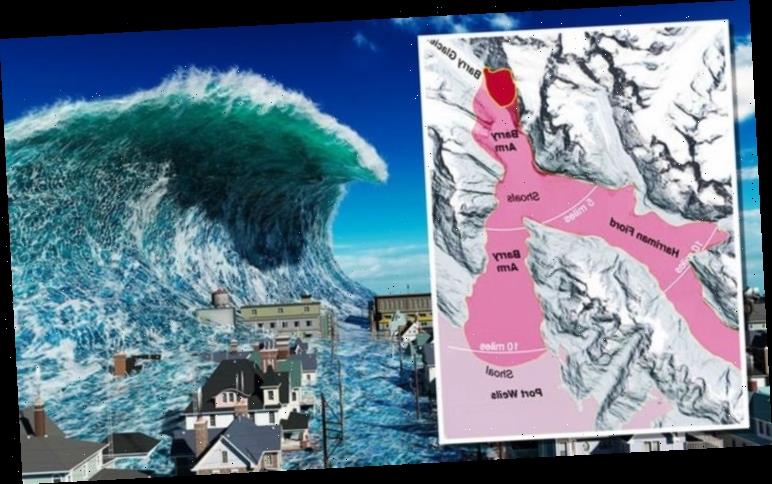Scientists fear the resulting event could happen “within the next year” and would drastically outclass the 1958 Lituya Bay Mega Tsunami in Alaska. The 1958 cataclysm was triggered by a magnitude 7.8 earthquake and produced a 1,700ft wave that is believed to be the tallest wave in modern history. Now, the collapse of a mountainside near Alaska’s Barry Glacier has the potential to release 16 times more debris and 11 times more energy.
The threat was exposed by Ohio State researcher Chunli Dai who analysed satellite imagery of the Barry Arm fjord, just 60 miles east of Anchorage.
Dr Dai found an entire mountainside within the fjord was slowly but surely shifting.
If the entire mountainside ever collapses at once, the scientist believes the fjord’s shape would amplify the resulting wave into a major tsunami.
Dr Dai said: “It was hard to believe the numbers at first.
“Based on the elevation of the deposit above the water, the volume of land that was slipping and the angle of the slope, we calculated that a collapse would release 16 times more debris and 11 times more energy than Alaska’s 1958 Lituya Bay landslide and mega-tsunami.”
To put into perspective, the 1958 event released millions of cubic yards of debris about 2,000ft (600m) into a fjord.
The event has been compared to an atomic bomb going off as the resulting wave obliterated millions of trees in a wide radius.
Bill and Vivian Swanson who witnessed the cataclysm from Anchorage Bay said: “The glacier had risen in the air and moved forward so it was in sight. It must have risen several hundred feet.
“I don’t mean it was just hanging in the air. It seems to be solid, but it was jumping and shaking like crazy.
“Big chunks of ice were falling off the face of it and down into the water. That was six miles away and they still looked like big chunks.”
Dr Dai went on to confirm her observations by studying NASA Landsat data collected between 2013 and 2016.
She said: “With the wider perspective from Landsat, the movement of the slope was impossible to miss.
DON’T MISS…
Yellowstone volcano: What would happen if Yellowstone volcano erupted? [ANALYSIS]
Why Yellowstone volcano could erupt faster than thought [INSIGHT]
Asteroid warning: NASA says space rock will hit Earth ‘again someday’ [REPORT]
“You can see a whole section of the mountain between Cascade Glacier and Barry Glacier slumping toward the water.”
Between 2010 and 2017, the slope has moved forward by about 400ft (120m).
However, since 2017 it has moved very little – but the threat of collapse is there.
In May this year, Dr Dai was one of 14 scientists behind and open letter warning the mega-tsunami is likely to strike within the next 20 years.
The scientists warned bays up to 30 miles (50km) from the fjord could see 30ft-tall (nine metre) waves.
The letter reads: “This tsunami could impact areas
frequented by tourists, fishing vessels, and hunters (potentially hundreds of people at one time).
“We believe that is is possible that this landslide-generated tsunami will happen within the next year, and likely within 20 years.”
Earthquakes, prolonged rain, hot weather driving permafrost thaw, and snow are all factors that could accelerate the landslide.
The scientists are now coordinating with state and federal partners to properly evaluate the risk.
Source: Read Full Article





